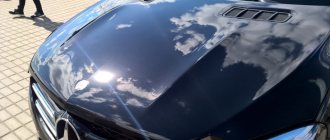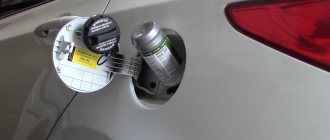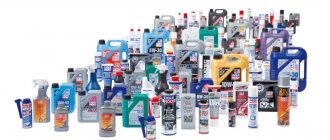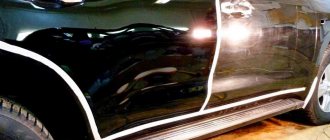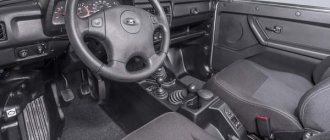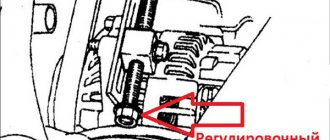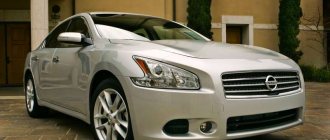Liquid glass evenly covers the car, giving it a perfect gloss. The thickness of liquid glass of several microns, of course, will not save the car from rubbing against curbs or getting deep scratches. But it protects the car from rust, dust, resin, and branches when driving on dirt roads.
In order for liquid glass to fit perfectly and get an excellent result, you need to pay special attention to preparing the machine: washing it, wiping off stains, degreasing, grinding, removing all small scratches. If the preparation stage of the car is not performed very well, then after applying liquid glass, all scratches and coating defects will be even more visible.
What is liquid glass
Liquid glass or ceramic varnish is a special polish for treating the paint surface of a car body. Consists of silicates - salt compounds of silicon. It is because of its similarity in composition to glass that it got its name. This is a relatively “new” invention of the Japanese, who developed a unique polish composition in 2008. Until this time, to care for the paintwork, the body was polished with wax-based materials.
Further developments allowed the transition from wax to silicon-based polishes. The composition remains in a liquid state, unlike ordinary glass, due to the lack of calcium. Liquid glass is a multicomponent substance that contains polymer compounds of silicon dioxide. It fills with a thin film all the irregularities on the applied surface, providing a high degree of protection for the paintwork.
Nanoceramics or liquid glass for cars – which is better?
Choice of ceramics or liquid glass
Car owners do not see the difference between ceramics and liquid glass. In 90% of cases these terms are used as synonyms. But in fact there is a slight difference between them. And it consists of additional processing at high temperatures - under the influence of heat, ordinary liquid glass turns into ceramics.
If we compare both options, it should be noted that nanoceramics:
- has an ordered molecular structure;
- has increased strength;
- has good adhesion;
- lasts up to 2 years;
- stands out for its resistance to chemical and thermal influences;
- is above average.
In contrast, liquid glass has:
- chaotic molecular structure;
- more liquid consistency;
- affordable price;
- service life about a year;
- coupling only with metal.
Important! Summarizing the above, we can say that it is advisable to apply nanoceramics to premium cars that are operated in a gentle mode. Liquid glass is more suitable for the economy segment.
Main components of liquid glass
- Titanium and aluminum oxide . Creates a thin film on the paint surface that has a thermal protective function. It is due to titanium oxide and aluminum that the applied composition gives a glossy shine.
- Silica . Provides strength, heat resistance and durability of the coating.
- Silicone base . Increases the adhesion of the coating to the car paint and prevents oxidation processes.
- Surfactants are surfactants. Liquid glass uses the same surfactants that are added to conventional detergents. No matter how well the surface of the body is prepared for processing, traces of contamination still remain on it. Surfactants are designed to combat them by repelling dirt particles from the surface.
- Additional additives included in the composition of other polymer films.
Scope of application of liquid glass
In addition to car body polish, liquid glass (with various variations in chemical composition) is used in the following areas:
- Mechanical engineering. In this industrial field, the substance is used to make foundry mixture.
- The paper industry uses liquid to make pulp.
- In construction, it is added to mortars to create acid-resistant concrete.
- Chemical industry. The substance is used more widely in this industry. It is included in many detergents and cleaning products. It is also added to the paint material so that the final coating has a shine.
In order for the substance to be used as a polish, its composition is slightly changed. Its formula eliminates elements that can negatively affect the top layer of paintwork. In this area of application, it is not liquid glass in its pure form. It is called that to identify it among other car body care products.
Why apply liquid glass to your car?
A new car, coming off the assembly line, has a perfect shiny glossy surface and a beautiful bright color. He is aesthetically very beautiful and attractive. Over time, during use, the car imperceptibly loses its shine and beauty. Its surface is covered with small scratches, chips, cracks, and abrasions. And outwardly it begins to be significantly inferior to the new car.
For some, this doesn’t matter at all: the main thing is that the car drives. For others, the appearance of the car is very important and emphasizes the status and success of the owner. And some people just want to own a beautiful car. In this case, there is a way to return the car to its original appearance and former beauty - liquid glass.
Wax-based polishes do a good job of this function, but their effect is short-lived and the polishing procedure must be repeated again and again. Modern polishes - liquid glass - allow you to achieve the desired effect for a much longer period.
In addition to polishing the body, liquid glass can be applied to headlights; it restores the smooth structure of the glass, removes haze and scratches and makes the light from the headlights brighter.
Applying liquid glass to the surface of the car allows you to wash the car less often, since the paintwork becomes less susceptible to dirt; dirt particles simply do not linger on the car, but bounce off it. If the car gets caught in the rain, there are no smudges left on the surface from drops, which means you don’t have to wash the car after every rain.
The strength of liquid glass applied to the surface of a car depends on its initial condition and the preparation carried out.
The effectiveness of liquid glass coating depends on:
- the newer the car, the stronger the effect will be: a new car has industrial varnish, so the final result will be the most durable and hard;
- if the car has been repainted, then the strength of the liquid glass will be less, since the varnishes used in the repair are much “softer” than the factory ones;
- If the machine has repainted parts, and moreover, if the paint was applied at different times, then for a good result such a machine will require more thorough preparation and grinding before applying liquid glass.
You should not expect that after applying liquid glass the saturation, brightness and depth of the color of the car will increase. The color will remain the same, and such a statement is nothing more than a crude marketing ploy.
A car treated with liquid glass does not require as frequent washing as a regular car. After long trips, it is enough to rinse the car with clean water without detergents to remove dust. And the shiny surface instantly restores its appearance.
What does liquid glass give besides shine?
After applying liquid glass to the surface of the car, a protective film about 3 microns thick is formed on it as a result of the diffusion of film atoms into the paint.
Liquid glass film performs the following functions:
- protects the paintwork from exposure to direct sunlight, which has a detrimental effect on the paint, prevents fading and fading of the paint, preserves the depth and brightness of the original color of the car;
- has anti-corrosion protection, as it prevents oxygen from reaching the paint, thereby slowing down the processes of oxidation and rust;
- prevents contamination of the body, reducing the required number of washes, which also do not do anything good for the car’s paint;
- repels raindrops, reducing stains from drops;
- limits access to the paint of salts, sand and aggressive winter chemicals used to treat roads, increasing the service life of the car's paint;
- prevents minor damage to body paint: scratches, chips;
- has antistatic properties, preventing the body surface from becoming electrified.
How long does liquid glass last?
provide a guarantee of maintaining the effect for 2-3 years and 80 car washes. But, unfortunately, such an impressive lifespan of liquid glass only works in ideal European conditions: excellent roads, small temperature changes, absence of dirt, salts, sand and chemicals on the roads. In the harsh Russian realities, the service life of liquid glass is, at best, a year and a half.
Pros and cons of liquid glass
Before using liquid glass, you should weigh all the advantages and disadvantages of this polish and make an informed decision so as not to regret later.
So, the advantages of liquid glass:
- protects the car body from adverse atmospheric conditions;
- provides mechanical protection of the paintwork from minor scratches and chips;
- restores shine and depth of color, giving the car a “showroom” look;
- makes the surface perfectly smooth;
- does not distort the color of the car due to its transparency;
- the machine does not require frequent washing;
- The hydrophobic properties of the polish keep the car clean even in the rain.
Disadvantages of liquid glass:
- the coating lasts about a year, so this procedure will have to be repeated every year;
- the coating lasts less when using detergents when washing a car, so it is better to wash the car with plain water without additives and a soft sponge;
- a car with a high mileage will require particularly careful surface preparation before the first application of liquid glass;
- the cost of the procedure is quite high, especially if processing with a grinding machine is required;
- at extremely low temperatures the coating may crack;
- in the event of an accident, the coating may also crack;
- crystallization of the polish occurs within 6-12 hours, during which you cannot drive the car;
- It is recommended to wash the car no earlier than a week after applying liquid glass.
Surface preparation and coating of a car with liquid glass
The process of applying liquid glass to a car consists of several stages and is quite labor-intensive. If the machine has been in use for a long time, preparing its surface will take even more time and effort. Usually this procedure is done at a car service center, but some owners cover the car with liquid glass themselves.
Stages of preparing the machine and applying liquid glass
1. It is necessary to wash and dry the car especially carefully. It is not recommended to wash it by hand, since it will not be possible to clean it properly this way. It is better to wash the car at a car wash using fairly aggressive detergents.
2. To work with liquid glass, you need a clean, closed room with good lighting and a minimum amount of dust. Ideally, this is a paint booth room.
3. You may need a grinding machine, an installation for drying parts, and skills in working with a grinding machine so as not to spoil the car’s paintwork.
4. Next comes degreasing and primary polishing of the body, glass and headlights. If the car has deep defects in the paintwork, which happen on cars with significant mileage, then deep polishing with abrasive components is used. Difficulties may arise when individual areas of the surface have a different state of varnish coating and abrasive polishing cannot be used on them.
5. If the initial polishing did not remove gross surface defects, then additional processing will have to be done.
6. After the initial polishing, a final polishing is done - “mirror”, the results of which will determine the duration of the liquid glass effect.
7. The liquid glass itself is applied in several layers. The minimum quantity is four layers: preparatory, two main and final. The more layers are applied, the better and longer the result will be. You can apply 10-12 layers.
8. The final stage is drying the coating for 12-15 hours.
Excursion to the manufacturers
In the modern car cosmetics market there is a wide variety of polishes, which are called liquid glass. Among them there are products worthy of attention, but you can often find counterfeits. Although such options are also liquid glass, the lack of experience in production affects the quality of the product, so it is better to opt for those companies that have proven themselves to be quality products.
The following brands occupy leading positions among manufacturers specializing in the production of high-quality liquid glass for cars.
Wilson Silane
The first on the list is the Japanese manufacturer, since chemists from this country were the first to develop this body polishing product, and therefore have more experience than other brands. Wilson Silane products are more common on the car cosmetics market.
To distinguish the original from a fake, you should pay attention to:
- Price. The original will cost more than analogues from other manufacturers. The price can be compared with the information on the company's website. If a store sells a product at a “hot” price, then most likely it is a fake. An exception may be a sale related to the liquidation of a store. In this case, the cost of all product categories will be reduced.
- Packaging. The box with original products always has the company's label printed in several places (Wilson in red letters on a white background). The product name must contain the word “Guard”.
- Complete set. In addition to the bottle of liquid, the package should contain microfiber, a sponge, a glove and an instruction manual (in Japanese).
Bullsone
The South Korean company sells products of no less quality than the previous manufacturer. The bottle is equipped with a sprayer, which facilitates the process of applying liquid to the body.
The product can be applied in several layers at intervals of a month. This creates a thicker film. The protective layer prevents the base layer of paint from fading. The product is sold in containers of 300 lm.
Mothers
The products of this American company are no less popular than their Japanese counterpart. The product catalog contains a wide variety of products for cosmetic car care.
Using different categories of polishing materials may give better results. For example, you can first apply Micro-Polishing Glaze (also called glaze), and then Pure Brazilian Carnauba Wax (wax polish). Some users even note a change in the color of the car.
Sonax
Another well-known brand specializing in the production of all kinds of car care products. The product of the German manufacturer, just like the previous ones, is not cheap.
Compared to wax polishes, this solution lasts longer on the surface, however, according to some customers, it masks scratches worse (than more expensive analogues). In view of this, before applying the product, it is necessary to polish the scratched areas using abrasive pastes. How this procedure is performed is described here.
Most often they try to counterfeit Wilson Silane products, since they cost an order of magnitude more than similar products. It is much less common to find a fake from a German or American manufacturer.
HKC Ceramic Coating
The product of the Estonian manufacturer belongs to the category of materials for professional use. Ceramic Coating liquid is well distributed over the surface. According to the manufacturer, 50 milliliters is enough for two treatments.
The film does not lose its strength up to 80 washes. Some owners of cars with metallic paint shades especially liked the product. The car began to look original thanks to the creation of a prism effect.
Soft99 Glass Coating H-7
The product of the Japanese manufacturer has a one-component composition. Thanks to this, it can be stored for a long time. Suitable for processing plastic, paintwork, metal and chrome parts.
